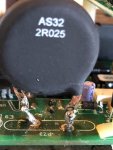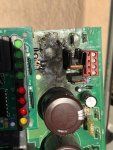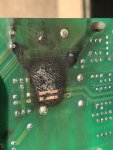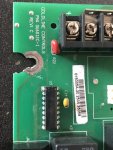Hello,
I’m new to the forum. I am, also, a relatively new pool owner. It came with the home I bought about 1 1/2 years ago. The pool/equipment is ~14 years old (except for the Intelliflow VS pump I had installed about a year ago). The previous owner of the home did not replace his salt cell after it failed several years earlier and just had his pool service manage the chemistry manually. He left me a new replacement Optimum Simple Cell, which I installed and switched-on over a year ago when I took over the pool care, shortly after the home purchase.
About 6 weeks ago, after over a year of a having a ‘trouble-free pool’, I noticed some algae growth in the pool and discovered that the original Goldline Aquarite (see model # in photo below) was not functioning. After researching the issue I performed the thermistor (AS32 2R025) swap on the board (I did it the “easy” way by snipping off the old legs and soldering the new legs to the old (see photo)). I fired it back up and it worked fine for over a month.
Last week I noticed algae growth, again, and found that the Aquarite had failed for a second time, only this time, it was my solder joint that had failed. It appeared that the solder had melted, opening the connection on the thermistor legs (I’m not very accomplished at soldering). A buddy of mine, who repairs electronic equipment, re-soldered the joints more soundly and we plugged it back in. The rejoice of the “generating” LED coming on was quickly stifled by the panic when thick black smoke began to emminate from behind the faceplate! We d/c’d the power to the panel immediately. The damage is seen in the photos below.
I have several questions that I could use some help with:
*Is anyone aware of this ever happening to an SWG panel?
*Could this be caused by the off-brand salt cell? An internal short?
*Any ideas on the cause? Shorted solder joint? Too much current draw from
another component? Thermistor failure? Transformer failure? Something melted
or shorted during the repair?
*When replacing the board, which model/version should I purchase.
*Should I replace the transformer and/or the salt cell, as well?
*Are there any current readings that I should take on the power supply to diagnose or rule-out causes?
As you may guess, I’m a little leary about having this happen again, since it could have spread to the house if unattended.
Any help that you can give me would be greatly appreciated!
-Steve
BTW: I just noticed that the equipment listed in my signature info is not completely correct. I have the Aquarite, not the Intellichlor system. And, as I mentioned I replaced the single speed pump.
I’m new to the forum. I am, also, a relatively new pool owner. It came with the home I bought about 1 1/2 years ago. The pool/equipment is ~14 years old (except for the Intelliflow VS pump I had installed about a year ago). The previous owner of the home did not replace his salt cell after it failed several years earlier and just had his pool service manage the chemistry manually. He left me a new replacement Optimum Simple Cell, which I installed and switched-on over a year ago when I took over the pool care, shortly after the home purchase.
About 6 weeks ago, after over a year of a having a ‘trouble-free pool’, I noticed some algae growth in the pool and discovered that the original Goldline Aquarite (see model # in photo below) was not functioning. After researching the issue I performed the thermistor (AS32 2R025) swap on the board (I did it the “easy” way by snipping off the old legs and soldering the new legs to the old (see photo)). I fired it back up and it worked fine for over a month.
Last week I noticed algae growth, again, and found that the Aquarite had failed for a second time, only this time, it was my solder joint that had failed. It appeared that the solder had melted, opening the connection on the thermistor legs (I’m not very accomplished at soldering). A buddy of mine, who repairs electronic equipment, re-soldered the joints more soundly and we plugged it back in. The rejoice of the “generating” LED coming on was quickly stifled by the panic when thick black smoke began to emminate from behind the faceplate! We d/c’d the power to the panel immediately. The damage is seen in the photos below.
I have several questions that I could use some help with:
*Is anyone aware of this ever happening to an SWG panel?
*Could this be caused by the off-brand salt cell? An internal short?
*Any ideas on the cause? Shorted solder joint? Too much current draw from
another component? Thermistor failure? Transformer failure? Something melted
or shorted during the repair?
*When replacing the board, which model/version should I purchase.
*Should I replace the transformer and/or the salt cell, as well?
*Are there any current readings that I should take on the power supply to diagnose or rule-out causes?
As you may guess, I’m a little leary about having this happen again, since it could have spread to the house if unattended.
Any help that you can give me would be greatly appreciated!
-Steve
BTW: I just noticed that the equipment listed in my signature info is not completely correct. I have the Aquarite, not the Intellichlor system. And, as I mentioned I replaced the single speed pump.






